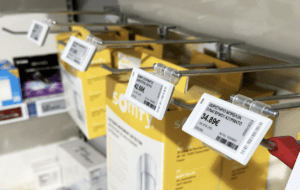Introduction
Alors que le secteur de la vente au détail poursuit sa transformation numérique, les étiquettes électroniques de rayon (ESL) apparaissent comme un outil clé pour optimiser les opérations des magasins physiques et améliorer l’engagement des clients. Les étiquettes électroniques, qui remplacent les étiquettes de prix traditionnelles en papier par des affichages numériques, offrent une approche flexible, dynamique et axée sur les données pour gérer les informations sur les prix et les stocks directement dans les rayons. Ce guide fournit une vue d’ensemble des ESL, étayée par des données quantitatives, afin d’aider les PDG à comprendre comment ces technologies s’alignent sur la stratégie du commerce de détail, améliorent l’efficacité opérationnelle et renforcent l’expérience du client.
L’état de la numérisation du commerce de détail

Les détaillants s’efforcent de plus en plus de combler le fossé entre la commodité des achats en ligne et l’expérience en magasin. Une étude réalisée en 2023 par McKinsey & Company a révélé que 78 % des PDG du secteur de la vente au détail considèrent que les solutions numériques en magasin sont essentielles pour rester compétitif (McKinsey, 2023). Les ESL font partie de ce changement numérique, offrant un moyen pratique d’intégrer la technologie dans les magasins tout en stimulant l’efficacité opérationnelle et l’engagement de la marque.
Qu’est-ce qu’une étiquette électronique de rayonnage (ESL) ?
Les ESL sont des dispositifs numériques qui affichent en temps réel les prix et les informations sur les produits dans les rayons des magasins. Généralement dotées de la technologie e-ink ou LED, ces étiquettes sont gérées de manière centralisée, ce qui permet des mises à jour rapides et cohérentes. Cette capacité rend les ESL particulièrement attrayants pour les détaillants qui ont besoin d’ajuster les prix de manière dynamique ou de synchroniser les promotions en magasin avec les ventes en ligne.
Avantages quantitatifs de la mise en œuvre de ESL
- Efficacité opérationnelle accrue
Les étiquettes papier traditionnelles obligent les employés des magasins à changer manuellement les étiquettes de prix lors d’événements commerciaux ou lorsque les prix des produits sont modifiés. Ce processus prend beaucoup de temps et nécessite une main-d’œuvre importante. Les ESL permettent de modifier les prix de milliers d’unités de stock en quelques minutes. Selon Deloitte, l’utilisation des ESL peut réduire de 80 % le temps consacré à la mise à jour des prix, libérant ainsi des employés pour le service à la clientèle et d’autres tâches importantes (Deloitte, 2022). - Réduction des erreurs de tarification
L’exactitude des prix est cruciale pour la confiance des clients et la conformité. Les étiquettes électroniques éliminent virtuellement les erreurs humaines associées à l’étiquetage manuel, réduisant ainsi les écarts de prix qui peuvent conduire à l’insatisfaction des clients ou à des problèmes juridiques. Une étude réalisée par PwC a révélé que les magasins utilisant des étiquettes électroniques avaient 97 % d’erreurs de prix en moins que ceux utilisant des étiquettes traditionnelles (PwC, 2022). - Possibilités de tarification dynamique
L’un des avantages les plus importants des ESL est la possibilité de mettre en place une tarification dynamique. Les détaillants peuvent réagir instantanément aux changements du marché, aux prix des concurrents et aux niveaux de stock. Par exemple, les ASP peuvent automatiquement réduire les prix des produits dont la date de péremption est proche afin d’encourager les ventes. Une étude réalisée en 2021 par Retail Systems Research a montré que les détaillants qui ont adopté la tarification dynamique à l’aide des ASP ont vu leur chiffre d’affaires augmenter de 12 % en un an (Retail Systems Research, 2021). - Amélioration de l’engagement des clients
Les ASP sont de plus en plus souvent intégrés à des fonctions intelligentes telles que les codes QR et les étiquettes NFC, que les clients peuvent utiliser pour accéder aux détails des produits, aux avis ou aux informations promotionnelles sur leurs smartphones. Carrefour a constaté une augmentation de 15 % des taux d’interaction avec les clients après la mise en place des ASP, ce qui suggère un impact positif sur l’expérience en magasin et la satisfaction des clients (Rapport annuel de Carrefour, 2023).
L’anglais langue seconde et le développement durable
Le développement durable est une préoccupation majeure pour les chefs d’entreprise de tous les secteurs, et les étiquettes ESL contribuent de manière positive aux objectifs de développement durable des entreprises. En réduisant la nécessité de réimprimer fréquemment les étiquettes de prix en papier, les étiquettes ESL contribuent à minimiser le gaspillage de papier. Un rapport publié en 2020 par Accenture estime qu’un supermarché moyen pourrait économiser environ 1,3 tonne de papier par an en adoptant les étiquettes ESL (Accenture, 2020). Cela permet non seulement de réduire les coûts, mais aussi de soutenir les efforts visant à réduire l’impact environnemental de l’entreprise.
Analyse coûts-avantages
Pour les chefs d’entreprise, il est essentiel de déterminer si les avantages des ALS l’emportent sur les coûts. L’investissement initial dans l’infrastructure ESL peut être substantiel, en fonction de la taille et des besoins du magasin. Les coûts comprennent les unités ESL , l’intégration du logiciel et l’installation. Le coût initial moyen d’un système ESL dans un magasin de taille moyenne est estimé entre 40 000 et 70 000 dollars (Frost & Sullivan, 2022). Toutefois, il est essentiel de mettre en balance ces coûts avec les économies opérationnelles à long terme.
- Économies de coûts de main-d’œuvre: Les ESL peuvent réduire de manière significative les coûts de main-d’œuvre associés aux mises à jour manuelles des prix. Si un magasin emploie deux personnes pendant 10 heures par semaine pour mettre à jour les étiquettes, les ESL pourraient permettre d’économiser environ 20 000 dollars par an en coûts de main-d’œuvre, sur la base des salaires moyens dans le commerce de détail.
- Impact de l’optimisation des prix: Les ASP améliorent la capacité d’un détaillant à mettre en œuvre une tarification dynamique, ce qui peut considérablement augmenter la rentabilité. Une étude de cas réalisée par IDC a montré que les supermarchés utilisant des ASP ont vu leurs bénéfices augmenter de 4 % en moyenne au cours de la première année (IDC, 2023).
Défis liés à l’adoption de l’anglais langue seconde
En dépit de ces avantages, la mise en œuvre de l’ESL comporte des défis.
- Investissement initial: Le capital requis pour l’installation peut être élevé, ce qui peut être prohibitif pour les petits détaillants. Toutefois, certains fournisseurs proposent des modèles d’abonnement permettant d’étaler les coûts dans le temps.
- Intégration technique: L’intégration des ASP aux systèmes de gestion des stocks et de points de vente existants peut s’avérer techniquement difficile. Une enquête réalisée par Retail Gazette a révélé que 35 % des détaillants ont cité les difficultés d’intégration comme un obstacle important à l’adoption des LEF (Retail Gazette, 2023).
- Formation des employés: Une mise en œuvre réussie nécessite une formation du personnel à la gestion et au dépannage du système ESL . Toutefois, de nombreux détaillants estiment que les systèmes sont faciles à utiliser après la formation initiale.
Études de cas : Histoires de réussite

- Le programme pilote de Walmart
En 2022, Walmart a lancé un programme pilote dans certains magasins d’Amérique du Nord afin d’évaluer l’efficacité du site ESL . Au bout d’un an, l’entreprise a constaté une réduction de 9 % des coûts de main-d’œuvre liés aux changements de prix et une amélioration significative de la satisfaction des clients (Walmart Corporate, 2023). Le projet pilote a également démontré une capacité accrue à concurrencer les détaillants en ligne en alignant les prix en temps quasi réel. L’entreprise prévoit maintenant de déployer le système dans plus de 2 000 magasins d’ici à 2026. - Le déploiement complet de Carrefour
Carrefour a adopté les ASP dans tous ses magasins français à partir de 2021. Les ESL ont permis de rationaliser les opérations et de réduire de 14 % les coûts associés aux démarques dues à l’inexactitude des prix. Cette initiative s’inscrit également dans le cadre des objectifs de développement durable de Carrefour, puisqu’elle permet d’économiser environ 10 000 tonnes de papier par an (Rapport annuel de Carrefour, 2023).
L’évolution technologique de l’anglais langue seconde
Le marché du site ESL a considérablement évolué au cours de la dernière décennie. Les premières versions étaient de simples affichages numériques, tandis que les ESL d’aujourd’hui offrent des capacités avancées :
- Ecrans à encre électronique: La technologie de l’encre électronique est aujourd’hui largement utilisée, car elle offre une grande visibilité et consomme peu d’énergie.
- Intégration RFID et NFC: Les ESL modernes intègrent les technologies RFID et NFC pour améliorer le suivi des stocks et l’interaction avec les clients.
- Contrôle centralisé du nuage: Les systèmes basés sur le cloud permettent aux détaillants de gérer à distance les prix et les stocks sur plusieurs sites, ce qui est particulièrement avantageux pour les grandes chaînes qui ont besoin d’une cohérence entre les régions.
Croissance du marché et tendances futures

Le marché mondial ESL était évalué à 830 millions de dollars en 2023 et devrait croître à un taux de croissance annuel moyen de 17,8 % entre 2024 et 2030, pour atteindre un montant estimé à 2,5 milliards de dollars d’ici 2030 (Grand View Research, 2023). Cette croissance est due à une adoption accrue dans divers secteurs de la vente au détail, notamment l’épicerie, l’électronique et la mode, ainsi qu’à des avancées technologiques qui améliorent la proposition de valeur des ESL.
Acteurs clés du marché ESL
- ApolloTechné: Acteur local canadien, Apollotechné fournit des solutions ESL personnalisées, adaptées aux petites et moyennes entreprises de vente au détail en Amérique du Nord. Son expertise réside dans les déploiements agiles et le soutien localisé, ce qui en fait un excellent choix pour les propriétaires/exploitants indépendants, les franchisés et les chaînes régionales axées sur la pharmacie, la quincaillerie et l’épicerie.
- SES-imagotag: Actuellement le plus grand fournisseur mondial de ESL , SES-imagotag détient environ 50 % des parts de marché. Leurs systèmes sont connus pour leur évolutivité et leurs intégrations avancées.
- Pricer AB: Entreprise suédoise, Pricer a une forte présence en Europe et se concentre sur des technologies innovantes telles que la communication infrarouge pour les ALS.
- Données d’affichage: Basée au Royaume-Uni, Displaydata est connue pour l’importance qu’elle accorde à la personnalisation et à la facilité d’intégration avec les systèmes de vente au détail existants.
Comment les ASP contribuent aux objectifs stratégiques du commerce de détail
- Cohérence entre les canaux: Dans l’environnement actuel de la vente au détail, il est crucial de maintenir des prix cohérents dans les magasins physiques et en ligne. Les ESL permettent une synchronisation transparente des prix, garantissant que les clients reçoivent des informations uniformes quel que soit le canal.
- Une expérience client améliorée: Les ASP améliorent l’expérience d’achat en fournissant des informations claires et précises. De nombreux ESL peuvent également afficher des détails supplémentaires sur les produits, tels que l’origine, les informations sur les allergènes et les évaluations des clients, afin de répondre aux besoins des acheteurs à la recherche d’informations.
- Gestion des stocks et de la demande en temps réel: Les ESL peuvent être intégrés aux systèmes d’inventaire afin de refléter la disponibilité des stocks en temps réel. Associé à la prévision de la demande, ce système permet une gestion plus souple des stocks, réduisant ainsi le risque de rupture de stock ou de surstockage.
Caractéristiques et capacités avancées des ALS

- Tarification dynamique
La tarification dynamique devient plus sophistiquée avec l’intégration de l’apprentissage automatique et de l’intelligence artificielle (IA) dans les ASP. Les algorithmes d’IA analysent les conditions du marché, les prix pratiqués par les concurrents, les comportements d’achat des clients et les niveaux de stock afin de déterminer les stratégies de prix optimales. Les détaillants commencent à tirer parti de ces capacités de tarification avancées pour maximiser les ventes et minimiser le gaspillage, en particulier dans les secteurs où les prix peuvent fluctuer considérablement, tels que l’épicerie et l’électronique grand public.
Par exemple, les épiciers peuvent fixer de manière dynamique le prix des denrées périssables à l’approche de leur date de péremption, ce qui incite les clients à les acheter à prix réduit. Une étude pilote menée par la Harvard Business Review a révélé que la tarification dynamique alimentée par des systèmes ESL pilotés par l’IA a permis de réduire de 10 % le gaspillage alimentaire tout en augmentant la rentabilité de 6 % (Harvard Business Review, 2023). - Promotions personnalisées et intégration de la fidélisation
Une autre caractéristique avancée des ASP est leur capacité à offrir des promotions personnalisées. Grâce à l’intégration des programmes de fidélisation, les ASP peuvent afficher des promotions uniques destinées à des clients individuels. Lorsqu’un client scanne l’étiquette d’un produit à l’aide de l’application de son smartphone liée au programme de fidélisation du magasin, le site ESL peut adapter le prix affiché en fonction du statut de fidélisation ou des préférences de ce client. Cette forme de micro-ciblage permet de créer des expériences plus attrayantes et plus gratifiantes pour les clients fidèles, ce qui, en fin de compte, renforce l’affinité avec la marque et la fidélisation des clients.
Une étude de Gartner (2023) montre que les promotions personnalisées pilotées par les ESL peuvent augmenter les taux de conversion des clients jusqu’à 25 %, car les clients se sentent plus proches des offres personnalisées qui correspondent à leur historique d’achat. - Capacités multilingues
Les ESL prennent également en charge plusieurs langues, ce qui est particulièrement avantageux pour les détaillants opérant sur des marchés multiculturels. D’une simple pression sur un bouton, les ESL peuvent afficher des informations sur les produits en plusieurs langues, ce qui permet aux clients d’origines diverses de se sentir plus à l’aise et mieux informés lors de leurs achats. La commodité offerte par les ALS multilingues a été associée à une augmentation de 7 % des ventes parmi les clients dont la langue maternelle n’est pas l’anglais dans plusieurs études de cas menées dans des chaînes de magasins européennes (EuroCommerce, 2023).
Impact sur la chaîne d’approvisionnement et la gestion des stocks
- Visibilité et précision des stocks
L’intégration des ESL aux systèmes de gestion des stocks permet non seulement de garantir l’exactitude des prix, mais aussi d’obtenir des informations en temps réel sur les niveaux de stock. Lorsque les niveaux de stock changent, par exemple lorsque des articles sont vendus ou réapprovisionnés, les ESL peuvent s’ajuster automatiquement pour indiquer la disponibilité des stocks, ce qui améliore la transparence des stocks et permet d’éviter les ruptures de stock ou les situations de surstockage.
Une étude menée par le Massachusetts Institute of Technology (MIT) en 2022 a révélé que les détaillants qui intégraient les étiquettes électroniques à leurs systèmes de gestion des stocks obtenaient une précision des stocks supérieure de 15 % à celle des détaillants qui utilisaient des méthodes d’étiquetage conventionnelles (MIT, 2022). Une meilleure précision des stocks minimise les radiations coûteuses et améliore la capacité d’un détaillant à répondre efficacement à la demande des consommateurs. - Réapprovisionnement automatisé des stocks
Les ESL peuvent également être intégrés à des systèmes automatisés de réapprovisionnement des stocks. Cette intégration permet aux détaillants de générer automatiquement des bons de commande lorsque les niveaux de stock tombent en dessous d’un certain seuil, garantissant ainsi que les articles les plus demandés sont toujours disponibles sur les étagères des magasins. Le réapprovisionnement automatisé des stocks aide les détaillants à gérer plus efficacement leurs chaînes d’approvisionnement et réduit le risque de pertes de ventes dues à des ruptures de stock.
Selon un rapport de Capgemini (2023), les systèmes de réapprovisionnement automatisés basés sur le site ESL peuvent réduire les coûts de stockage de 18 % et augmenter les taux de disponibilité des stocks à plus de 98 %. Ces améliorations de l’efficacité de la chaîne d’approvisionnement font des ESL un outil indispensable pour les détaillants qui cherchent à optimiser leurs pratiques de gestion des stocks.
L’avenir de l’anglais langue seconde : Tendances émergentes et innovations

- Intégration de l’IdO et des magasins intelligents
L’Internet des objets (IoT) transforme le paysage de la vente au détail, et les ESL jouent un rôle important dans les écosystèmes de magasins intelligents. Les ESL peuvent communiquer avec d’autres dispositifs IoT en magasin, tels que des caméras, des capteurs et des chariots intelligents, afin d’offrir une expérience d’achat interconnectée et transparente. Par exemple, les caméras équipées de la vision par ordinateur peuvent détecter le comportement du client, comme le fait de prendre et de poser un produit, et déclencher des offres personnalisées sur le site ESL pour augmenter la probabilité de conversion.
Les magasins intelligents utilisant des systèmes ESL interconnectés font état d’une plus grande satisfaction des clients et d’un panier plus important. Une étude réalisée en 2023 par l’Institut Fraunhofer a révélé que la mise en œuvre d’ASP intégrés à l’IdO dans les magasins a entraîné une augmentation de 15 % du temps de séjour des clients et de 9 % de la valeur moyenne des transactions (Institut Fraunhofer, 2023). - Solutions énergétiques durables
Avec la prise de conscience environnementale, les détaillants s’efforcent de réduire leur empreinte carbone grâce à des technologies durables. Les ESL évoluent pour inclure des panneaux solaires et des capacités de collecte d’énergie, ce qui leur permet de fonctionner avec une dépendance minimale à l’égard des batteries. Cette innovation s’inscrit non seulement dans les objectifs de développement durable des entreprises, mais contribue également à réduire les coûts opérationnels liés au remplacement et à l’entretien des batteries.
SES-imagotag, l’un des leaders du marché, a récemment lancé des ESL à énergie solaire qui devraient permettre d’économiser 30 % des coûts énergétiques par rapport aux ESL traditionnels fonctionnant avec des batteries (Communiqué de presse SES-imagotag, 2023). Au fur et à mesure que la technologie des énergies renouvelables progresse, les ESL alimentés par l’énergie solaire sont susceptibles de devenir la norme de l’industrie, consolidant encore davantage les ESL en tant que solution écologique pour le commerce de détail. - Intégration de la réalité augmentée (RA)
Les ASP sont de plus en plus souvent intégrés à la réalité augmentée (RA) afin d’offrir une expérience d’achat immersive. Lorsque les clients pointent leur smartphone vers les ASP dotés de fonctions de réalité augmentée, ils peuvent voir des visuels de produits améliorés, des essayages virtuels et des informations supplémentaires sur les produits en surimpression sur leur écran. Grâce à la RA, les clients peuvent visualiser plus facilement les détails des produits et prendre des décisions d’achat en connaissance de cause.
Les détaillants qui pilotent des ALS intégrés à la RA, comme ceux des secteurs de l’électronique et de l’aménagement de la maison, ont fait état d’un engagement accru et d’une augmentation de 5 % des taux de conversion (Retail Technology Review, 2023). À mesure que la technologie de la RA se généralise, cette intégration pourrait redéfinir l’expérience d’achat en magasin et contribuer à combler le fossé entre la vente au détail en ligne et hors ligne.
Conclusion : Votre entreprise doit-elle investir dans l’apprentissage de l’anglais langue seconde ?
Pour les chefs d’entreprise qui envisagent de recourir aux ASP, la décision se résume à mettre en balance les gains d’efficacité à long terme et les coûts d’investissement à court terme. Les avantages quantitatifs – réduction de la main-d’œuvre, amélioration de la précision, tarification dynamique, amélioration de l’expérience client et gains en termes de durabilité – démontrent clairement la valeur que peuvent offrir les ASP.
Les détaillants axés sur l’innovation et la compétitivité à long terme sont susceptibles de trouver que les ESL constituent un investissement rentable. À mesure que les attentes des consommateurs évoluent, l’adoption de technologies qui améliorent l’efficacité des magasins, réduisent l’impact sur l’environnement et améliorent l’expérience d’achat sera cruciale. Dans un secteur où les marges sont souvent étroites, les ESL peuvent apporter l’avantage concurrentiel nécessaire pour que le commerce de détail physique prospère à l’ère du numérique.
Prochaines étapes
Pour explorer les avantages que les ALS peuvent apporter à votre commerce de détail ou pour planifier une consultation, communiquez avec notre équipe dès aujourd’hui. Nous nous engageons à vous aider à transformer vos opérations en magasin et à profiter des avantages de cette technologie novatrice. Nos experts peuvent fournir une évaluation personnalisée de vos besoins et vous guider tout au long du processus de mise en œuvre, en veillant à ce que vous tiriez le meilleur parti de votre investissement dans les ALS. Laissez-nous vous aider à franchir la prochaine étape vers des opérations de vente au détail plus intelligentes et plus efficaces.






